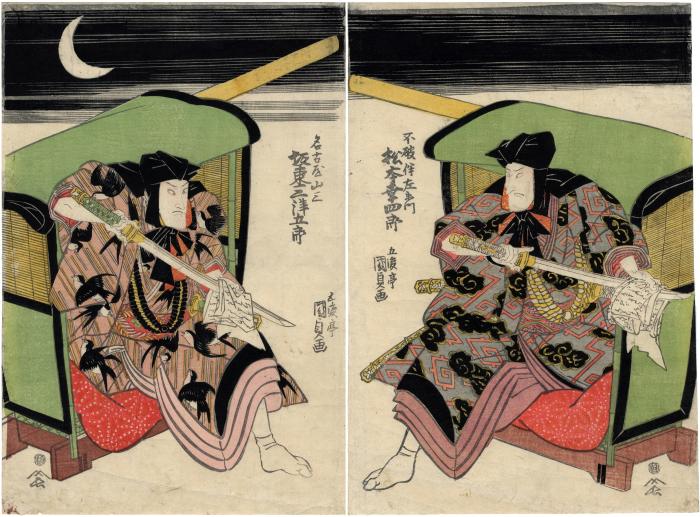Utagawa Kunisada (歌川国貞) / Toyokuni III (三代豊国) (artist 1786 – 01/12/1865)
Diptych of Bandō Mitsugorō III (坂東三津五郎) as Nagoya Sanzaburō (名古屋山三) on the left and Matsumoto Kōshirō V (松本幸四郎) as Fuwa Banzaemon (不破伴左衛門) on the right in the play Fuwa Nagoya Yuki no Tategasa (不破名護屋雪棹)
11/1816
20.75 in x 15.375 in (Overall dimensions) Japanese woodblock print
Signed: Gototei Kunisada ga
五渡亭国貞画
Publisher: Hiranoya Chōemon
(Marks 112 - seal 02-055)
Censor's seal: kiwame
Tokyo Metropolitan Library
Ethnologische Sammlung des Museums Natur und Mensch, Freiburg
Musée d’art et d’histoire, Ville de Genève - the left panel only There is a novel from 1807 by Santō Kyōden, Mukashi banashi inazuma hyoshi (An Old Time Lightning Bolt Tale) in which the two major antagonists wear kimonos which identify them iconographically. Fuwa Banzaemon carries a sword called 'Thunder' and wears robes with a lightning and cloud motif (kumo ni inazuma). His opponent Nagoya Sanzaburō's sword is the 'Amorous Swallows' and his robe is decorated with the 'swallows-in-the-rain' motif.
****
In Andon 96 in an article by Herwig, Vos and Griffith says on page 52: "... the characters and.story are based on the popular play The floating world's pattern and matching lightning bolts (Ukiyozuka hiyoku no inazuma), written by Tsuruya Nanboku IV (1755-1829) in 1823. Nanboku's play dramatized the rivalry between two samurai who were competing for the love of a courtesan, and his script was, in turn, largely based on Santō Kyōden's (1761-1876) novel An old-time lightning-bolt tale (Mukashi gatari inazuma byōshi), published in 1806. The immense popularity of Nanboku's play ensured its enduring fame and, as is quite common in Kabuki, certain of the play's most celebrated scenes came to be staged independently."
Both men are wiping their swords with letters. There must be a reason for this scene. It is also interesting to note that the costume of Fuwa Banzaemon is decorated with a black cloud and flashing lightning bolts while that of Nagoya Sanzaburō shows swallows flying in the rain (ame ni nure tsubame). Many of the costumes for Sanzaburō show a motif of three umbrellas. We know of one from as early as 1742. His bird motif appears as early as 1766 sans the rain.
In footnote 45 on page 64 of the previously cited Andon article it quotes from the lines of the play written by Nanboku:
Fuwa: "Do you not know? Watching the start of a lighting storm at Fuwa Barrier, you rush through the gate hiding beneath a deep sedge hat. Are you returning after being jilted, like a bird in the rain?" Nagoya: "To a love soaked heart I would lend a nesting place beneath my umbrella, a rain-drenched swallow".****
Isn't it interesting the motifs of the corresponding robes of these characters may well be an indication of their opposition, their antipathy.
While it is hardly noticeable at all, the actor on the left, Bandō Mitsugorō III, is wearing an outfit that barely shows his obi, but on that obi is an even more hidden partial crest of this particular man, the hanakatsumi (花勝見) or four petaled flower that was used by Bandō clan. In fact, Bandō Mitsugorō III often wore an obi with this crest, and can be seen on other representations of him in the Lyon Collection.
Hiranoya Chōemon (平野屋長右衛門) (publisher)
actor prints (yakusha-e - 役者絵) (genre)
Bandō Mitsugorō III (三代目坂東三津五郎: 11/1799 to 12/1831) (actor)
Matsumoto Kōshirō V (五代目松本幸四郎: 11/1801 to 5/1838) (actor)
Fuwa Banzaemon (不破伴左衛門) (role)
